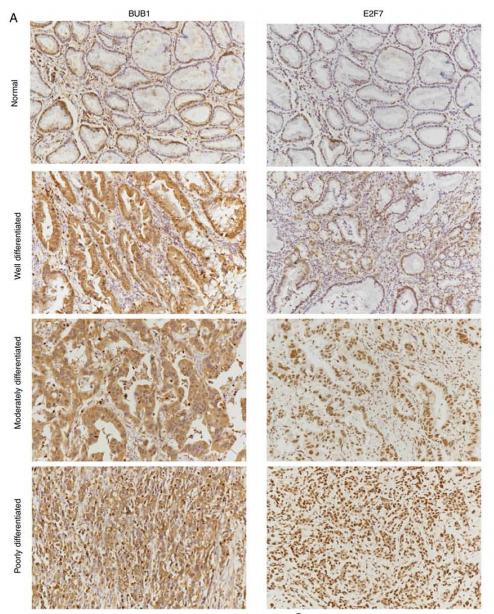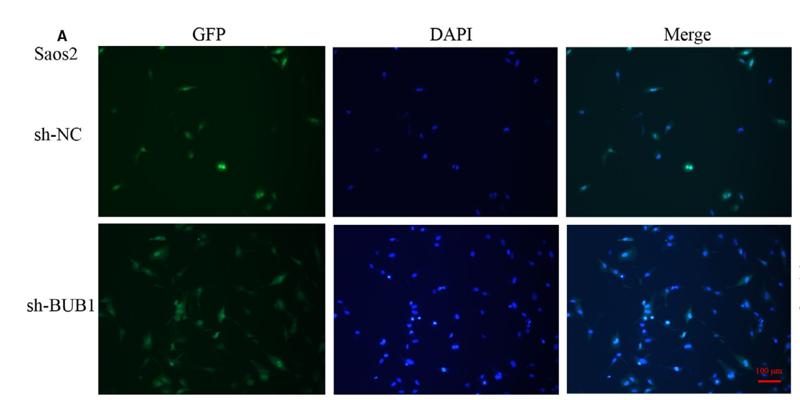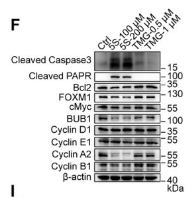| 产品: | BUB1 抗体 |
| 货号: | DF6698 |
| 描述: | Rabbit polyclonal antibody to BUB1 |
| 应用: | WB IHC |
| 文献验证: | WB, IHC |
| 反应: | Human, Mouse, Rat |
| 预测: | Rabbit, Dog |
| 分子量: | 122kDa; 122kD(Calculated). |
| 蛋白号: | O43683 |
| RRID: | AB_2838660 |
产品描述
*The optimal dilutions should be determined by the end user.
*Tips:
WB: 适用于变性蛋白样本的免疫印迹检测. IHC: 适用于组织样本的石蜡(IHC-p)或冰冻(IHC-f)切片样本的免疫组化/荧光检测. IF/ICC: 适用于细胞样本的荧光检测. ELISA(peptide): 适用于抗原肽的ELISA检测.
引用格式: Affinity Biosciences Cat# DF6698, RRID:AB_2838660.
展开/折叠
Bub1; BUB1 budding uninhibited by benzimidazoles 1 homolog; BUB1 budding uninhibited by benzimidazoles 1 homolog (yeast); BUB1 mitotic checkpoint serine/threonine kinase; BUB1, S. cerevisiae, homolog of; BUB1_HUMAN; BUB1A; BUB1L; Budding uninhibited by benzimidazoles 1 (yeast homolog); Budding uninhibited by benzimidazoles 1 homolog; Budding uninhibited by benzimidazoles 1, S. cerevisiae, homolog of; hBUB1; Homolog of mitotic checkpoint gene BUB1; Mitotic checkpoint gene BUB1; Mitotic checkpoint serine/threonine protein kinase BUB1; Mitotic checkpoint serine/threonine-protein kinase BUB1; Mitotic spindle checkpoint kinase; Putative serine/threonine protein kinase;
抗原和靶标
High expression in testis and thymus, less in colon, spleen, lung and small intestine. Expressed in fetal thymus, bone marrow, heart, liver, spleen and thymus. Expression is associated with cells/tissues with a high mitotic index.
- O43683 BUB1_HUMAN:
- Protein BLAST With
- NCBI/
- ExPASy/
- Uniprot
MDTPENVLQMLEAHMQSYKGNDPLGEWERYIQWVEENFPENKEYLITLLEHLMKEFLDKKKYHNDPRFISYCLKFAEYNSDLHQFFEFLYNHGIGTLSSPLYIAWAGHLEAQGELQHASAVLQRGIQNQAEPREFLQQQYRLFQTRLTETHLPAQARTSEPLHNVQVLNQMITSKSNPGNNMACISKNQGSELSGVISSACDKESNMERRVITISKSEYSVHSSLASKVDVEQVVMYCKEKLIRGESEFSFEELRAQKYNQRRKHEQWVNEDRHYMKRKEANAFEEQLLKQKMDELHKKLHQVVETSHEDLPASQERSEVNPARMGPSVGSQQELRAPCLPVTYQQTPVNMEKNPREAPPVVPPLANAISAALVSPATSQSIAPPVPLKAQTVTDSMFAVASKDAGCVNKSTHEFKPQSGAEIKEGCETHKVANTSSFHTTPNTSLGMVQATPSKVQPSPTVHTKEALGFIMNMFQAPTLPDISDDKDEWQSLDQNEDAFEAQFQKNVRSSGAWGVNKIISSLSSAFHVFEDGNKENYGLPQPKNKPTGARTFGERSVSRLPSKPKEEVPHAEEFLDDSTVWGIRCNKTLAPSPKSPGDFTSAAQLASTPFHKLPVESVHILEDKENVVAKQCTQATLDSCEENMVVPSRDGKFSPIQEKSPKQALSSHMYSASLLRLSQPAAGGVLTCEAELGVEACRLTDTDAAIAEDPPDAIAGLQAEWMQMSSLGTVDAPNFIVGNPWDDKLIFKLLSGLSKPVSSYPNTFEWQCKLPAIKPKTEFQLGSKLVYVHHLLGEGAFAQVYEATQGDLNDAKNKQKFVLKVQKPANPWEFYIGTQLMERLKPSMQHMFMKFYSAHLFQNGSVLVGELYSYGTLLNAINLYKNTPEKVMPQGLVISFAMRMLYMIEQVHDCEIIHGDIKPDNFILGNGFLEQDDEDDLSAGLALIDLGQSIDMKLFPKGTIFTAKCETSGFQCVEMLSNKPWNYQIDYFGVAATVYCMLFGTYMKVKNEGGECKPEGLFRRLPHLDMWNEFFHVMLNIPDCHHLPSLDLLRQKLKKVFQQHYTNKIRALRNRLIVLLLECKRSRK
种属预测
score>80的预测可信度较高,可尝试用于WB检测。*预测模型主要基于免疫原序列比对,结果仅作参考,不作为质保凭据。
High(score>80) Medium(80>score>50) Low(score<50) No confidence
研究背景
Serine/threonine-protein kinase that performs 2 crucial functions during mitosis: it is essential for spindle-assembly checkpoint signaling and for correct chromosome alignment. Has a key role in the assembly of checkpoint proteins at the kinetochore, being required for the subsequent localization of CENPF, BUB1B, CENPE and MAD2L1. Required for the kinetochore localization of PLK1. Required for centromeric enrichment of AUKRB in prometaphase. Plays an important role in defining SGO1 localization and thereby affects sister chromatid cohesion. Acts as a substrate for anaphase-promoting complex or cyclosome (APC/C) in complex with its activator CDH1 (APC/C-Cdh1). Necessary for ensuring proper chromosome segregation and binding to BUB3 is essential for this function. Can regulate chromosome segregation in a kinetochore-independent manner. Can phosphorylate BUB3. The BUB1-BUB3 complex plays a role in the inhibition of APC/C when spindle-assembly checkpoint is activated and inhibits the ubiquitin ligase activity of APC/C by phosphorylating its activator CDC20. This complex can also phosphorylate MAD1L1. Kinase activity is essential for inhibition of APC/CCDC20 and for chromosome alignment but does not play a major role in the spindle-assembly checkpoint activity. Mediates cell death in response to chromosome missegregation and acts to suppress spontaneous tumorigenesis.
Upon spindle-assembly checkpoint activation it is hyperphosphorylated and its kinase activity toward CDC20 is stimulated. Phosphorylation at Thr-609 is required for interaction with PLK1, phosphorylation at this site probably creates a binding site for the POLO-box domain of PLK1, thus enhancing the PLK1-BUB1 interaction.
Ubiquitinated and degraded during mitotic exit by APC/C-Cdh1.
Nucleus. Chromosome>Centromere>Kinetochore.
Note: Nuclear in interphase cells. Accumulates gradually during G1 and S phase of the cell cycle, peaks at G2/M, and drops dramatically after mitosis. Localizes to the outer kinetochore. Kinetochore localization is required for normal mitotic timing and checkpoint response to spindle damage and occurs very early in prophase. AURKB, KNL1 and INCENP are required for kinetochore localization (By similarity).
High expression in testis and thymus, less in colon, spleen, lung and small intestine. Expressed in fetal thymus, bone marrow, heart, liver, spleen and thymus. Expression is associated with cells/tissues with a high mitotic index.
Interacts with BUB3 and KNL1. Interacts (when phosphorylated) with PLK1. The BUB1-BUB3 complex interacts with MAD1L1.
(Microbial infection) Interacts with SV40 Large T antigen; this interaction induces activation of a DNA damage response and promotes p53/TP53 stabilization and phosphorylation.
(Microbial infection) Interacts with herpes virus 8 protein LANA1.
The KEN box is required for its ubiquitination and degradation.
BUB1 N-terminal domain directs kinetochore localization and binding to BUB3.
Belongs to the protein kinase superfamily. Ser/Thr protein kinase family. BUB1 subfamily.
研究领域
· Cellular Processes > Cell growth and death > Cell cycle. (View pathway)
· Cellular Processes > Cell growth and death > Oocyte meiosis. (View pathway)
· Organismal Systems > Endocrine system > Progesterone-mediated oocyte maturation.
文献引用
Application: WB Species: Mice Sample: OS cells
Application: IF/ICC Species: Mice Sample: OS cells
Application: IHC Species: Rat Sample: gastric tissue
Application: IHC Species: human Sample: gastric cancer
Application: WB Species: Human Sample: HuCCT1 cells
限制条款
产品的规格、报价、验证数据请以官网为准,官网链接:www.affbiotech.com | www.affbiotech.cn(简体中文)| www.affbiotech.jp(日本語)产品的数据信息为Affinity所有,未经授权不得收集Affinity官网数据或资料用于商业用途,对抄袭产品数据的行为我们将保留诉诸法律的权利。
产品相关数据会因产品批次、产品检测情况随时调整,如您已订购该产品,请以订购时随货说明书为准,否则请以官网内容为准,官网内容有改动时恕不另行通知。
Affinity保证所销售产品均经过严格质量检测。如您购买的商品在规定时间内出现问题需要售后时,请您在Affinity官方渠道提交售后申请。产品仅供科学研究使用。不用于诊断和治疗。
产品未经授权不得转售。
Affinity Biosciences将不会对在使用我们的产品时可能发生的专利侵权或其他侵权行为负责。Affinity Biosciences, Affinity Biosciences标志和所有其他商标所有权归Affinity Biosciences LTD.




